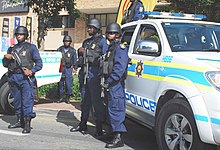South African Police Service
[4] Amnesty International and others have expressed serious concerns about South African police brutality, including torture and extrajudicial killings.[5][6][7] The South African Police Service traces its origin to the Dutch Watch, a paramilitary organisation formed by settlers in the Cape Province in 1655 to protect civilians and to maintain law and order.When the National Party (NP) edged out its more liberal opponents in nationwide elections in 1948, the new government enacted legislation that strengthened the relationship between the police and the military.70) of 1965 allowed police to detain any person, receptacle, vehicle, aircraft, or premises within one mile of any national border, and to seize anything found without a warrant.As of March 2023[update], there were three Deputy National Commissioners, with each of these split into divisions as follows:[12] A new ranking system of the South African Police Service was adopted in April 2010.[22] Through the early-1990s, the police were equipped with smoke and tear-gas dispensing vehicles, tank trucks with water cannons, vehicles that dispensed barbed wire or razor wire to cordon off areas, and a number of rotor and fixed wing aircraft for surveillance, ground force management, rapid deployment of Task Force and specialist teams to crime scenes and VIP personnel movements.[29] The department was criticised by the Western Cape Government for providing the lowest number personnel (adjusted for population) with a shortage of 2,392 officers,[30] despite having the highest murder rate.Amnesty International has expressed concerns about police brutality, including torture and extrajudicial killings, in South Africa.[42] In April 2009, SAPS attempted to ban unFreedom Day[43] and was implicated in support for September 2009 ANC mob that attacked the elected leadership of the shack settlement at Kennedy Road, Durban."[51] In February 2013, police in Daveyton, Gauteng were caught on video brutalising Mido Macia, a Mozambican taxi driver accused of parking illegally.[56] It later emerged that the violence had actually started on 11 August when leaders from the National Union of Mineworkers opened fire on striking NUM members killing two.[59] It is the country's deadliest incident between police and the civilian population since the Sharpeville Massacre of 1960, and has been referred to as a turning-point in post-1994 South Africa.However, journalists at the Mail and Guardian claim to have solid information supporting the widespread suspicion that President Mbeki suspended Pikoli as part of a bid to shield Police Commissioner Selebi.[74] On 12 October 2020, Lieutenant-General Bonang Mgwenya, the country's second-most senior police official, was arrested on charges of corruption, fraud, theft and money laundering involving about R200-million and afterwards appeared in Ridge Magistrates court.[78] On 28 December 2020, three law enforcement officers who were employed by the Emalahleni Municipality were arrested in Mpumalanga on corruption and bribery charges which involved allegations of not issuing standard fines to motorists who committed traffic violations, but instead extorting them for bribes.
South African PoliceBritish South Africa PoliceHomelandSouth AfricaSenzo MchunuRepublic of South Africaprovincial bordersPretoriaConstitution of South AfricaAmnesty Internationalpolice brutalityCape ProvinceCape TownDurbanEastern CapeUnion of South AfricaFirst World WarSecond World War2nd Infantry DivisionSouth African ArmyNational PartySydney MufamadiZimbabweUnited KingdomCanadahomelandsMicki PistoriusStellenboschPolice and Prisons Civil Rights UnionSouth African Policing UnionapartheidFikile MbalulaGeneralLieutenant GeneralMajor GeneralBrigadierColonelLieutenant ColonelCaptainWarrant OfficerSergeantConstableRG-12 'Nyala'CasspirMine-Resistant Ambush Protected VehicleFord FocusBMW 3 SeriesVolkswagen Golf GTIMercedes-Benz VitoFord RangerEurocopter AS350Pilatus PC-6/B2-H4Beech King Air C90ACessna 680 Citation SovereignPilatus PC-12Eurocopter AS350 B3Robinson R44McDonnell-Douglas 369EMBB Bk 117B1Vektor R5Johannesburgpistolpepper sprayR5 rifletear gasSpecial Task ForceMarikana MassacreZuma RiotsKhayelitsha CommissionPolitical repression in post-apartheid South AfricaunFreedom DayKennedy Road, DurbanBlikkiesdorpDelft, Cape TownGauteng ProvinceThe TimesDaveytonMido MaciaMozambicanshooting of Nathaniel Juliesdown syndromeEldorado Park.Marikana miner strikeLonminMarikanaSharpeville MassacreJackie SelebiInterpolMail and GuardianBheki CeleJacob ZumaRiah PhiyegaGautengDirectorate for Priority Crime InvestigationEmalahleni MunicipalityIndependent Police Investigative Directoratemurder of Charl KinnearTheodorus Gustaff TruterIsaac Pierre de VilliersDSO & two barsPetrus Johann CoetzeeJohan Velde van der MerweJ. "Jackie" S. SelebiBheki H. CeleNhlanhla MkhwanaziMangwashi Victoria PhiyegaKhomotso PhahlaneKhehla John SitoleList of South African Battle HonoursRhodesiaMinister of PolicepresidentPaul TrewhelaDaily MaverickBBC NewsMail & GuardianNews24The London GazetteHawks ( Directorate for Priority Crime Investigation / SAPS)South African Police Service Special Task ForceDepartments of the Government of South AfricaThe PresidencyAgriculture, Land Reform and Rural DevelopmentBasic EducationCommunications and Digital TechnologiesCooperative Governance


